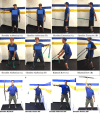Bodyblade™ Training in Athletes with Traumatic Anterior Shoulder Instability
- PMID: 36793570
- PMCID: PMC9897004
- DOI: 10.26603/001c.65900
Bodyblade™ Training in Athletes with Traumatic Anterior Shoulder Instability
Abstract
Background: The Bodyblade™ has the potential of enhancing conservative management of Traumatic Anterior Shoulder Instability (TASI).
Purpose: The purpose of this study was to compare three different protocols: Traditional, Bodyblade™, and Mixed (Traditional & Bodyblade™) for shoulder rehabilitation on athletes with TASI.
Study design: Randomized-controlled longitudinal training study.
Methods: Thirty-seven athletes (age = 19.9±2.0 years) were allocated into Traditional, Bodyblade™, and Mixed (Traditional/Bodyblade™) training groups (3×week for 8-weeks). The traditional group used resistance bands (10-15 repetitions). The Bodyblade™ group transitioned from classic to the pro model (30-60-s repetitions). The mixed group converted from the traditional (weeks 1-4) to the Bodyblade™ (weeks 5-8) protocol. Western Ontario Shoulder Index (WOSI) and the UQYBT were evaluated at baseline, mid-test, post-test, and at a three-month follow-up. A repeated-measures ANOVA design evaluated within and between-group differences.
Results: All three groups significantly (p=0.001, eta2: 0.496) exceeded WOSI baseline scores (at all timepoints) with training (Traditional: 45.6%, 59.4%, and 59.7%, Bodyblade™: 26.6%, 56.5%, and 58.4%, Mixed: 35.9%, 43.3% and 50.4% respectively). Additionally, there was a significant (p=0.001, eta2: 0.607) effect for time with mid-test, post-test and follow-up exceeding baseline scores by 35.2%, 53.2% and 43.7%, respectively. The Traditional and Bodyblade™ groups (p=0.049, eta2: 0.130) exceeded the Mixed group UQYBT at post-test (8.4%) and at three-month follow-up (19.6%). A main effect (p=0.03, eta2: 0.241) for time indicated that WOSI mid-test, post-test and follow-up exceeded the baseline scores by 4.3%, 6.3% and 5.3%.
Conclusions: All three training groups improved their scores on the WOSI. The Traditional and Bodyblade™ groups demonstrated significant improvements in UQYBT inferolateral reach scores at post-test and three-month follow-up compared to the Mixed group. These findings could lend further credibility to the role of the Bodyblade as an early to intermediate rehabilitation tool.
Level of evidence: 3.
Keywords: Western Ontario Shoulder Index; glenohumeral; instability; subluxation; upper quarter y-balance test.
Conflict of interest statement
The authors declare no conflicts of interest with the contents of this manuscript.
Figures
Similar articles
-
AN ELECTROMYOGRAPHIC ANALYSIS OF THE SHOULDER COMPLEX MUSCULATURE WHILE PERFORMING EXERCISES USING THE BODYBLADE® CLASSIC AND BODYBLADE® PRO.Int J Sports Phys Ther. 2016 Apr;11(2):175-89. Int J Sports Phys Ther. 2016. PMID: 27104051 Free PMC article.
-
Shoulder- and back-muscle activation during shoulder abduction and flexion using a Bodyblade Pro versus dumbbells.J Sport Rehabil. 2012 Aug;21(3):266-72. doi: 10.1123/jsr.21.3.266. Epub 2012 Jun 18. J Sport Rehabil. 2012. PMID: 22713233 Clinical Trial.
-
Arthroscopic Versus Open Stabilization for Anterior Shoulder Subluxations.Orthop J Sports Med. 2015 Jan 23;3(1):2325967115571084. doi: 10.1177/2325967115571084. eCollection 2015 Jan. Orthop J Sports Med. 2015. PMID: 26535374 Free PMC article.
-
Shoulder Stabilization Versus Immobilization for First-Time Anterior Shoulder Dislocation: A Systematic Review and Meta-analysis of Level 1 Randomized Controlled Trials.Am J Sports Med. 2023 May;51(6):1634-1643. doi: 10.1177/03635465211065403. Epub 2022 Feb 11. Am J Sports Med. 2023. PMID: 35148222
-
Conservative management following closed reduction of traumatic anterior dislocation of the shoulder.Cochrane Database Syst Rev. 2019 May 10;5(5):CD004962. doi: 10.1002/14651858.CD004962.pub4. Cochrane Database Syst Rev. 2019. PMID: 31074847 Free PMC article.
Cited by
-
Effect of Instability Training on Compensatory Muscle Activation during Perturbation Challenge in Young Adults.J Funct Morphol Kinesiol. 2023 Sep 15;8(3):136. doi: 10.3390/jfmk8030136. J Funct Morphol Kinesiol. 2023. PMID: 37754969 Free PMC article.
References
-
- Traumatic shoulder dislocation in the adolescent athlete: advances in surgical treatment. Good Christopher R, MacGillivray John D. Feb;2005 Current Opinion in Pediatrics. 17(1):25–29. doi: 10.1097/01.mop.0000147905.92602.bb. doi: 10.1097/01.mop.0000147905.92602.bb. - DOI - DOI - PubMed
-
- BESS/BOA patient care pathways: traumatic anterior shoulder instability. Brownson Peter, Donaldson Oliver, Fox Michael, Rees Jonathan L., Rangan Amar, Jaggi Anju, Tytherleigh-Strong Graham, McBernie Julie, Thomas Michael, Kulkarni Rohit. May 26;2015 Shoulder & Elbow. 7(3):214–226. doi: 10.1177/1758573215585656. doi: 10.1177/1758573215585656. - DOI - DOI - PMC - PubMed
-
- Eshoj Henrik, Rasmussen Sten, Frich Lars Henrik, Jensen Steen Lund, Søgaard Karen, Juul-Kristensen Birgit. BMC Musculoskeletal Disorders. 1. Vol. 20. Springer Science and Business Media LLC; Patients with non-operated traumatic primary or recurrent anterior shoulder dislocation have equally poor self-reported and measured shoulder function: a cross-sectional study; pp. 59–63. - DOI - DOI - PMC - PubMed
-
- The epidemiology of glenohumeral joint stability: incidence, burden, and long-term consequences. Cameron Kenneth L., Mauntel Timothy C., Owens Brett D. Sep;2017 Sports Medicine and Arthroscopy Review. 25(3):144–149. doi: 10.1097/jsa.0000000000000155. doi: 10.1097/jsa.0000000000000155. - DOI - DOI - PubMed
LinkOut - more resources
Full Text Sources
Research Materials

